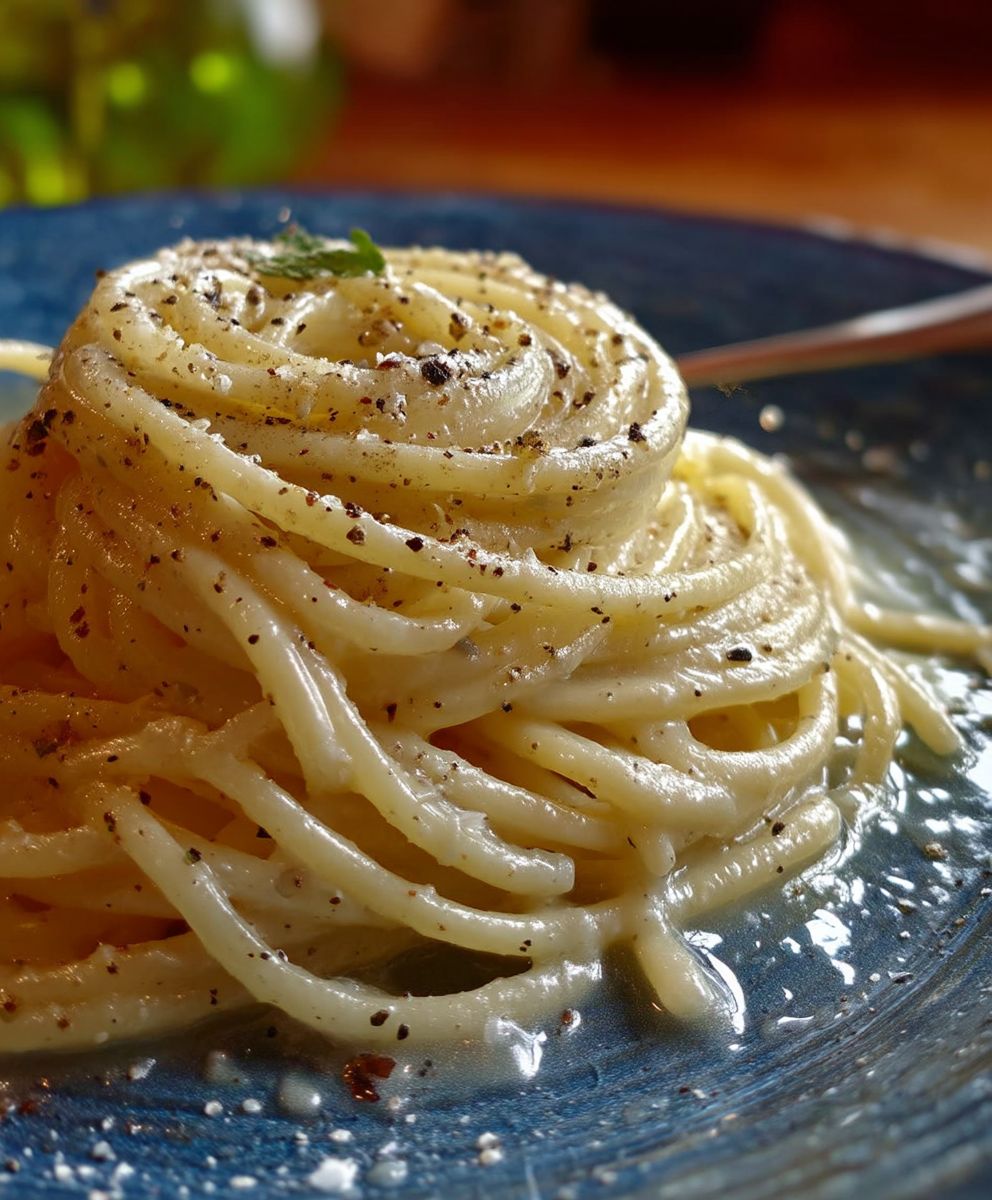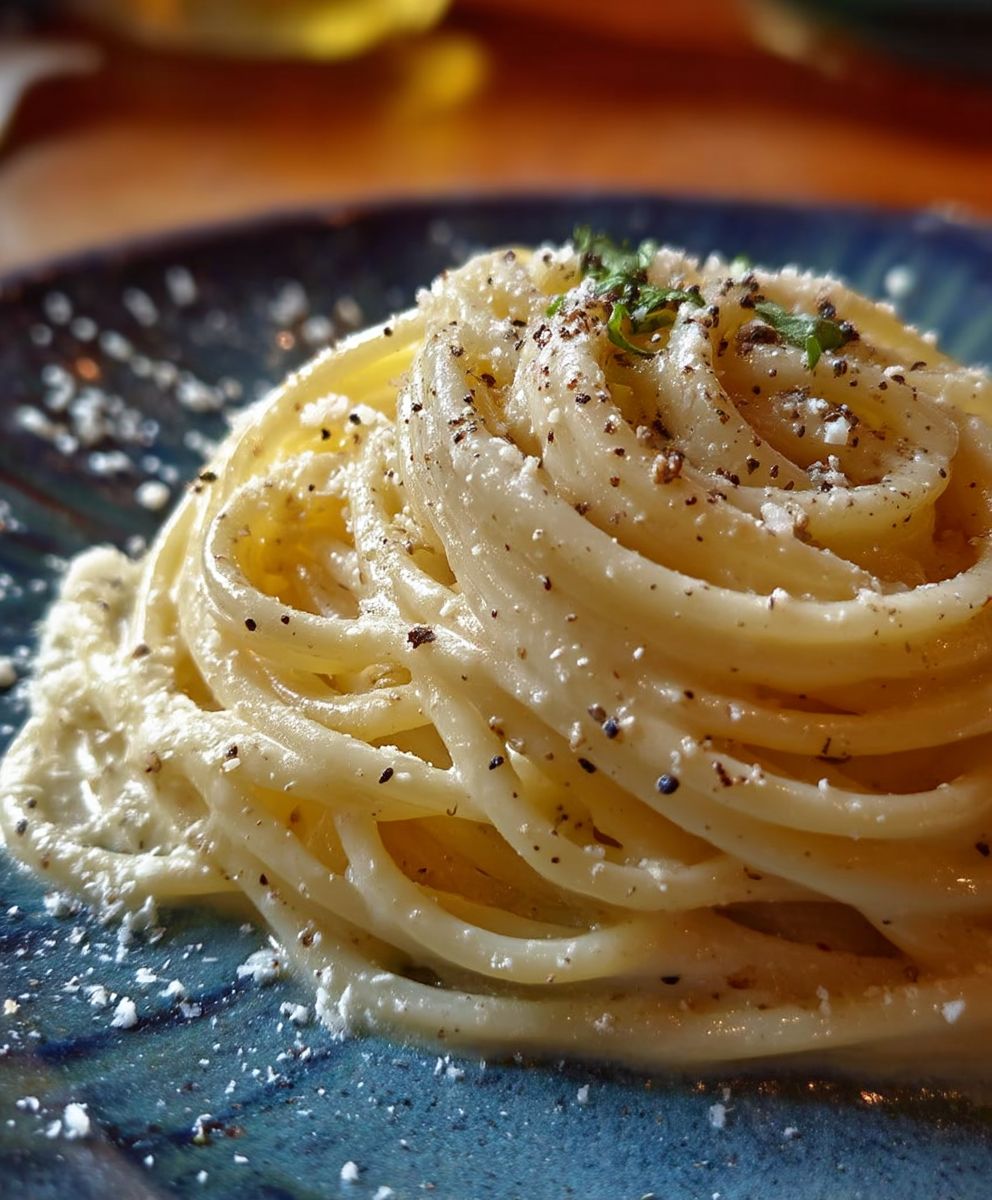Cacio e Pepe: three simple words that unlock a world of flavor. Have you ever craved a dish that’s both incredibly satisfying and surprisingly easy to make? A dish that whispers of ancient Roman culinary traditions with every delicious bite? Then look no further! This classic pasta dish, whose name literally translates to “cheese and pepper,” is about to become your new weeknight obsession.
The beauty of Cacio e Pepe lies in its minimalist approach. Born in Rome, this dish is a testament to the resourcefulness of shepherds who carried dried pasta and aged Pecorino Romano cheese with them. The simplicity of the ingredients pasta, Pecorino Romano cheese, and black pepper belies the complexity of the flavor profile. It’s a dish that demands respect for technique, as the creamy sauce is created not with cream, but with the starchy pasta water and the emulsified cheese.
People adore Cacio e Pepe for its comforting warmth and bold, peppery kick. The rich, salty cheese clings lovingly to each strand of pasta, creating a symphony of textures and tastes. Its quick to prepare, making it perfect for busy evenings, yet elegant enough to impress guests. Trust me, once you master the art of Cacio e Pepe, you’ll find yourself craving its simple perfection again and again. Let’s get cooking!
Ingredients:
- 1 pound (450g) spaghetti, preferably a good quality bronze-die cut
- 4 ounces (115g) Pecorino Romano cheese, finely grated (about 2 cups, packed)
- 2-3 tablespoons freshly cracked black peppercorns, coarsely ground
- 2-4 tablespoons reserved pasta water, plus more as needed
- 2 tablespoons unsalted butter (optional, but adds richness)
- Salt, to taste (be mindful of the saltiness of the Pecorino)
Preparing the Cheese and Pepper Mixture:
Okay, let’s get started! The key to a truly amazing Cacio e Pepe is all in the technique, and it starts with properly preparing our cheese and pepper mixture. This isn’t just about throwing everything together; it’s about creating a creamy, emulsified sauce that clings beautifully to the pasta.
- Grate the Pecorino Romano: This is crucial. Use a fine grater, like a microplane or a fine rasp grater. The finer the cheese, the easier it will melt and emulsify into a smooth sauce. Don’t use pre-grated cheese; it often contains cellulose, which prevents it from melting properly. Trust me, fresh is best here! Aim for about 2 packed cups of grated cheese.
- Grind the Black Pepper: Freshly cracked black pepper is non-negotiable. The pre-ground stuff just doesn’t have the same punch. Use a pepper grinder or, even better, a mortar and pestle to coarsely grind the peppercorns. You want to see some texture! The amount of pepper is really up to your preference. I like a generous 2-3 tablespoons, but feel free to adjust it to your liking. If you’re sensitive to spice, start with less and add more later.
- Combine Cheese and Pepper: In a medium-sized bowl, combine the grated Pecorino Romano cheese and the freshly ground black pepper. Mix them together thoroughly. This ensures that the pepper is evenly distributed throughout the cheese, which will help create a consistent flavor in the final dish.
Cooking the Spaghetti:
Next up, we need to cook our spaghetti to al dente perfection. The pasta water is a vital ingredient in Cacio e Pepe, so pay close attention to this step!
- Boil the Water: Fill a large pot with plenty of water (at least 6 quarts). Add a generous amount of salt enough to make the water taste like the sea. This seasons the pasta from the inside out. Bring the water to a rolling boil over high heat.
- Cook the Spaghetti: Add the spaghetti to the boiling water and cook according to the package directions, but subtract about 1-2 minutes from the recommended cooking time. You want the pasta to be al dente, meaning it should still have a slight bite to it. Remember, it will continue to cook a bit in the sauce.
- Reserve the Pasta Water: Before draining the pasta, use a measuring cup to reserve at least 1 cup (and preferably more) of the pasta water. This starchy water is liquid gold! It’s what will help create the creamy, emulsified sauce. Don’t discard it!
- Drain the Pasta: Drain the spaghetti quickly, but don’t rinse it! We want to keep that starchy coating on the pasta, as it will help the sauce cling.
Creating the Cacio e Pepe Sauce:
This is where the magic happens! The key to a smooth, creamy sauce is to slowly incorporate the pasta water into the cheese and pepper mixture, creating an emulsion. Patience is key here!
- Melt the Butter (Optional): If you’re using butter (and I highly recommend it!), melt it in the same pot you cooked the pasta in over medium-low heat. This adds a lovely richness to the sauce.
- Add Pasta to the Pot: Add the drained spaghetti to the pot with the melted butter (or just the empty pot if you’re skipping the butter).
- Start with a Little Pasta Water: Add about 2 tablespoons of the reserved pasta water to the pot with the spaghetti. Toss the pasta quickly to coat it with the water.
- Add the Cheese and Pepper Mixture Gradually: Now, this is important: don’t dump all the cheese and pepper mixture in at once! Add it in small increments, about 1/4 cup at a time. After each addition, toss the pasta vigorously with tongs to melt the cheese and create a creamy sauce.
- Continue Adding Pasta Water and Cheese: Continue adding pasta water and cheese, alternating between the two, and tossing constantly. The goal is to create a smooth, emulsified sauce that coats each strand of spaghetti. You may need to add more pasta water than you initially think. The amount will depend on the humidity, the type of pasta, and the cheese.
- Adjust Consistency: If the sauce becomes too thick, add a little more pasta water to thin it out. If it’s too thin, add a little more cheese. Keep tossing and adjusting until you reach the perfect consistency a creamy, luscious sauce that clings to the pasta.
- Taste and Season: Taste the Cacio e Pepe and season with salt, if needed. Remember that Pecorino Romano is already quite salty, so you may not need to add much. You can also add a bit more freshly ground black pepper, if desired.
Serving:
Time to enjoy the fruits of your labor! Serve your Cacio e Pepe immediately, as the sauce can thicken as it cools.
- Serve Immediately: Divide the Cacio e Pepe among serving bowls.
- Garnish (Optional): If you like, you can garnish with a sprinkle of extra grated Pecorino Romano cheese and a grind of fresh black pepper.
- Enjoy! Dig in and savor the simple yet incredibly delicious flavors of Cacio e Pepe.
Tips for Success:
- Use High-Quality Ingredients: The quality of your ingredients will directly impact the flavor of your Cacio e Pepe. Use good quality spaghetti, freshly grated Pecorino Romano cheese, and freshly cracked black pepper.
- Don’t Overcook the Pasta: Al dente pasta is essential for a good Cacio e Pepe. Overcooked pasta will become mushy and won’t hold the sauce well.
- Reserve Enough Pasta Water: Pasta water is the key to creating a creamy, emulsified sauce. Don’t be afraid to use more than you think you need.
- Add the Cheese Gradually: Adding the cheese in small increments, while tossing constantly, will help prevent it from clumping and ensure a smooth sauce.
- Work Quickly: Cacio e Pepe is best served immediately, as the sauce can thicken as it cools. Have everything prepared and ready to go before you start cooking the pasta.
- Don’t Be Afraid to Experiment: Once you’ve mastered the basic recipe, feel free to experiment with different variations. Try adding a pinch of red pepper flakes for a little heat, or using a different type of cheese, such as Parmesan.
Troubleshooting:
- Sauce is Clumpy: This usually happens when the cheese is added too quickly or the pasta water is not hot enough. Try adding a little more hot pasta water and tossing vigorously to break up the clumps.
- Sauce is Too Thin: Add a little more grated Pecorino Romano cheese and toss until the sauce thickens.
- Sauce is Too Thick: Add a little more hot pasta water and toss until the sauce reaches the desired consistency.
- Pasta is Sticking Together: Make sure you’re using enough water when cooking the pasta and that you’re stirring it frequently. Also, don’t rinse the pasta after draining it.
Cacio e Pepe is a deceptively simple dish, but it requires attention to detail and a bit of practice to perfect. Don’t be discouraged if your first attempt isn’t perfect. Keep practicing, and you’ll be making restaurant-quality Cacio e Pepe in no time!

Conclusion:
This isn’t just another pasta dish; it’s an experience. The simplicity of Cacio e Pepe belies its incredible depth of flavor, a testament to the magic that happens when high-quality ingredients meet perfect technique. I truly believe that once you master this recipe, it will become a staple in your kitchen, a go-to for those nights when you crave something comforting, satisfying, and utterly delicious. It’s quick enough for a weeknight meal but elegant enough to serve to guests.
Why is this Cacio e Pepe a must-try? Because it’s authentic, it’s achievable, and it’s unbelievably good. The creamy, cheesy sauce clings perfectly to the al dente pasta, delivering a peppery kick that awakens your taste buds. It’s a dish that celebrates the beauty of simplicity, proving that you don’t need a laundry list of ingredients to create something truly extraordinary. Forget complicated sauces and lengthy cooking times; this recipe is all about showcasing the pure, unadulterated flavors of Pecorino Romano cheese and freshly cracked black pepper.
But the best part? It’s incredibly versatile! While I’ve shared my classic rendition, feel free to experiment and make it your own.
Serving Suggestions and Variations:
* Elevate the experience: A drizzle of high-quality olive oil just before serving adds a touch of richness and complexity.
* Spice it up: For an extra kick, add a pinch of red pepper flakes to the sauce.
* Protein boost: Crispy pancetta or guanciale are fantastic additions, adding a salty, savory element.
* Vegetarian delight: Roasted vegetables like asparagus or zucchini pair beautifully with the creamy sauce.
* Wine Pairing: A crisp, dry white wine like Pinot Grigio or Vermentino complements the richness of the cheese and pepper perfectly.
* Pasta Power: While I recommend spaghetti, feel free to experiment with other pasta shapes like bucatini or tonnarelli. Each shape offers a slightly different texture and sauce-holding ability.
* Lemon Zest: A tiny bit of lemon zest can brighten the dish.
Don’t be intimidated by the simplicity of the ingredient list. The key to a truly exceptional Cacio e Pepe lies in the technique. Pay close attention to the water-to-pasta ratio, the temperature of the pasta water, and the emulsification process. With a little practice, you’ll be whipping up restaurant-quality Cacio e Pepe in no time.
I’m so excited for you to try this recipe and experience the magic of Cacio e Pepe for yourself. It’s a dish that has brought me so much joy, and I hope it does the same for you. So, gather your ingredients, put on some music, and get ready to create something truly special.
Once you’ve made it, I’d love to hear about your experience! Did you try any variations? What did you think of the flavor? Share your photos and comments below I can’t wait to see your creations! Happy cooking!
Cacio e Pepe: The Authentic Roman Recipe You Need to Try
Simple Roman pasta with spaghetti, Pecorino Romano, and black pepper. Creamy, flavorful, and ready in minutes!
Ingredients
- 1 pound (450g) spaghetti, preferably a good quality bronze-die cut
- 4 ounces (115g) Pecorino Romano cheese, finely grated (about 2 cups, packed)
- 2-3 tablespoons freshly cracked black peppercorns, coarsely ground
- 2-4 tablespoons reserved pasta water, plus more as needed
- 2 tablespoons unsalted butter (optional, but adds richness)
- Salt, to taste (be mindful of the saltiness of the Pecorino)
Instructions
- Prepare Cheese and Pepper: Finely grate the Pecorino Romano cheese using a microplane or fine rasp grater. Coarsely grind the black peppercorns using a pepper grinder or mortar and pestle. Combine the grated cheese and pepper in a medium bowl and mix thoroughly.
- Cook Spaghetti: Fill a large pot with at least 6 quarts of water. Add a generous amount of salt. Bring to a rolling boil. Add spaghetti and cook according to package directions, subtracting 1-2 minutes for al dente.
- Reserve Pasta Water: Before draining, reserve at least 1 cup (or more) of the pasta water.
- Drain Pasta: Drain the spaghetti quickly, without rinsing.
- Create Sauce: If using butter, melt it in the same pot over medium-low heat. Add the drained spaghetti to the pot.
- Incorporate Water and Cheese: Add 2 tablespoons of pasta water to the pot and toss. Gradually add the cheese and pepper mixture, about 1/4 cup at a time, tossing vigorously after each addition to melt the cheese and create a creamy sauce.
- Adjust Consistency: Continue alternating between adding pasta water and cheese, tossing constantly until a smooth, emulsified sauce coats the pasta. Add more pasta water if the sauce is too thick, or more cheese if it’s too thin.
- Season: Taste and season with salt, if needed. Add more black pepper to taste.
- Serve: Serve immediately in bowls, garnished with extra grated Pecorino Romano and fresh black pepper, if desired.
Notes
- Use high-quality ingredients for the best flavor.
- Don’t overcook the pasta; al dente is crucial.
- Reserve enough pasta water it’s essential for the creamy sauce.
- Add the cheese gradually to prevent clumping.
- Work quickly, as the sauce can thicken as it cools.
- If the sauce is clumpy, add more hot pasta water and toss vigorously.
- If the sauce is too thin, add more cheese.
- If the sauce is too thick, add more pasta water.





Leave a Comment